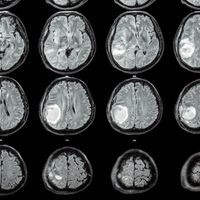Login
Subscribeglioblastoma

Mega Multiplexing for Exploring Diseased Tissues
Niki Spahich, PhD | Oct 16, 2023 | 4 min read
Researchers at KU Leuven specialize in performing a multiplex immunohistochemistry method that uses conventional antibodies and pathologist-driven data analysis.

Machine Learning for Predicting Glioblastoma Prognosis
Tanvir Khan, PhD | Oct 4, 2023 | 3 min read
Researchers integrate scRNA-seq, spatial transcriptomics, and histology imaging data to show that spatial cellular architecture predicts glioblastoma prognosis.

Viewing the Glioblastoma Tumor Microenvironment at Single Cell Resolution
The Scientist Staff | 1 min read
In this webinar, Matthias Brendel will discuss a new PET approached called scRadiotracing, which involves immunomagnetic cell sorting after in vivo radiotracer injection combined with 3D histology.

Capturing the Brain Tumor Microenvironment with Tissue Engineering
Deanna MacNeil, PhD | Aug 4, 2023 | 3 min read
Researchers built a 3D glioblastoma model to study therapeutic resistance and improve drug screening systems.

Turning up the Heat on Brain Tumors
Aparna Nathan, PhD | Jul 17, 2023 | 3 min read
Oncolytic viruses can help glioblastoma respond to immunotherapy.

Building Cancer Models with Creative Collaborators
Deanna MacNeil, PhD | 1 min read
Jennifer Munson shares how teamwork and collaboration have fostered her research at the intersection of creativity and clinical discovery.

Electric Fields Disrupt Cancer Cell Division
Danielle Gerhard, PhD | May 4, 2023 | 5 min read
A novel, non-invasive treatment using electrical currents exploits physiological properties of dividing cancer cells to prolong survival and augment current therapies.

Our Favorite Neuroscience Stories of 2022
Dan Robitzski | Dec 28, 2022 | 4 min read
This year, neuroscience researchers made important discoveries related to how neurodegeneration attacks the human brain, hooked cultured neurons up to machinery to teach them to play a video game, and more.

Stem Cell Engineering for Tissue Regeneration
The Scientist | 1 min read
Innovative strategies drive stem cell repair of organ damage.

Caught on Camera
The Scientist | Dec 12, 2022 | 4 min read
See some of the coolest images recently featured by The Scientist.

Astrocytes Feed Glioblastoma, Promoting Tumor Growth: Mouse Study
Patience Asanga | Oct 5, 2022 | 3 min read
Starving glioblastoma tumors of the cholesterol made by astrocytes could suppress brain cancer progression.

The Structure and Functions of the p53 Pathway: Information Acquisition, Redundancy, and Connectivity
The Scientist | 1 min read
Arnold Levine will discuss his discovery of p53 and the evolution of the field since then, and Jon Chen will discuss the use of single-cell phosphoproteomics in identifying changes in key signaling networks, including p53.

Glioblastoma Cells Imitate Immature Neurons to Invade the Brain
Sophie Fessl, PhD | Aug 5, 2022 | 3 min read
Neuron-like glioblastoma cells are the pioneers of deadly tumors’ spread through the brain, contributing to their devastating invasiveness, a study in mice finds.

A New Model with Fully Functioning Blood Vessels Mimics Brain Cancer
Roni Dengler, PhD | Sep 10, 2021 | 2 min read
A newly developed platform may one day replace cell culture and animal models to personalize cancer treatment.

Molecular Imaging Pioneer, Sanjiv “Sam” Gambhir, Dies at 57
Lisa Winter | Jul 28, 2020 | 3 min read
The Stanford Medical School professor’s research aided the development of positron emission tomography (PET) reporters to identify disease.

Zika as Cancer Buster?
Amy Schleunes | Apr 1, 2020 | 2 min read
By infecting glioblastoma cells but not healthy brain tissue, some form of the virus could serve a therapeutic purpose.

CAR T Cell Adds Scorpion Venom to Tackle Tumor Heterogeneity
Amy Schleunes | Mar 24, 2020 | 5 min read
A newly engineered CAR T cell that incorporates a peptide isolated from the venom of the deathstalker scorpion has broad brain tumor–binding capabilities that will be investigated in an upcoming clinical trial.

Air Pollution Tied to Brain Cancer: Study
Emily Makowski | Nov 13, 2019 | 2 min read
Inhaling combustion-produced particles may lead to the development of brain tumors.

Immune-Activating Gene Therapy for Glioblastoma
Ruth Williams | Aug 14, 2019 | 3 min read
The results of an early trial in 31 brain cancer patients finds immune activity boosted in the tumor, and possibly longer survival.
